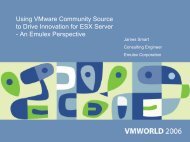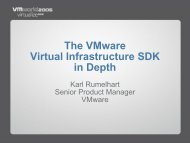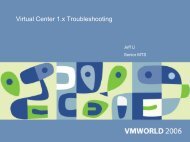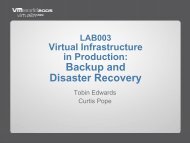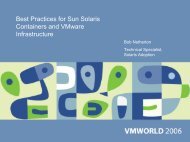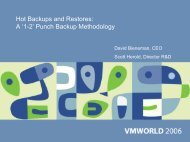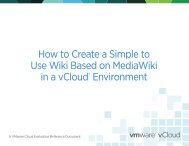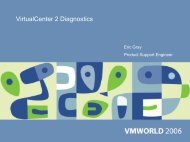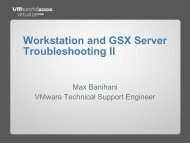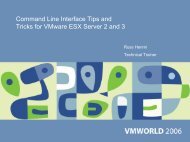ESX Server 3.0 Tips and Tricks - VMware
ESX Server 3.0 Tips and Tricks - VMware
ESX Server 3.0 Tips and Tricks - VMware
You also want an ePaper? Increase the reach of your titles
YUMPU automatically turns print PDFs into web optimized ePapers that Google loves.
<strong>ESX</strong> <strong>Server</strong> <strong>3.0</strong> <strong>Tips</strong> <strong>and</strong> <strong>Tricks</strong><br />
Mostafa Khalil, VCP<br />
<strong>VMware</strong> Product Support Engineering
Agenda<br />
Storage Area Network<br />
VMFS-3<br />
iSCSI Storage<br />
NFS
Storage Area Network (SAN)<br />
Components<br />
Topology<br />
Identification
SAN Components<br />
Initiators (host HBAs)<br />
QLogic 1/2/4Gb<br />
Emulex 1/2/4Gb<br />
See HCL for supportability<br />
Set HBA’s BIOS to “Point-to-Point” or similar to that<br />
Targets (Storage Processors’ Ports)<br />
Active/Active Arrays<br />
Active/Passive Arrays<br />
Check the HCL for supportability<br />
Fabrics (Switches <strong>and</strong> Fibre Connections)<br />
No specific listing on HCL<br />
1/2/4Gb switches<br />
May need to set switch port to “Fx” or equivalent (e.g. F-Port)
SAN Topology – Point-to-Point<br />
AKA Direct Connect<br />
Not supported<br />
Except CX100<br />
Storage<br />
SP<br />
HBA<br />
<strong>Server</strong>
SAN Topology – Absolute Minimum<br />
Switch allows additional<br />
connections of more storage or<br />
more servers<br />
No redundancy<br />
Many single points of failure<br />
Supported by <strong>VMware</strong> for <strong>ESX</strong><br />
<strong>Server</strong> as a bare minimum<br />
configuration<br />
If the Storage Arrays are not<br />
listed on the hardware<br />
compatibility list (HCL), <strong>VMware</strong><br />
only supports them with this<br />
simple configuration<br />
Storage<br />
SP<br />
FC Switch<br />
HBA<br />
<strong>Server</strong>
SAN Topology – Arbitrated Loop<br />
Not Supported<br />
HBA<br />
<strong>Server</strong><br />
Storage<br />
SP<br />
HBA<br />
<strong>Server</strong>
SAN Topology – Multipath Fabric<br />
Storage<br />
SP<br />
SP<br />
FC Switch<br />
HBA<br />
HBA<br />
HBA<br />
HBA<br />
<strong>Server</strong><br />
<strong>Server</strong>
SAN Topology – Fully Redundant Fabrics<br />
Recommended<br />
Storage<br />
SP1<br />
SP2<br />
FC Switch<br />
FC Switch<br />
HBA<br />
HBA<br />
HBA<br />
HBA<br />
<strong>Server</strong><br />
<strong>Server</strong>
Identifying SAN Configuration<br />
VI Client<br />
Console
Multipath Analysis<br />
Cannonical Name<br />
vmhbaC:T:L<br />
In this example<br />
Vmhba0:0:0<br />
Policy: MRU or Fixed<br />
In this Example: MRU<br />
Path States:<br />
On<br />
Off<br />
St<strong>and</strong>by<br />
Dead
Multipath Analysis - Identifying Targets<br />
SAN Type Port ID WWN<br />
EMC Clariion<br />
SPA0<br />
xx:xx:xx:60:xx:xx:xx:xx<br />
SPA1<br />
xx:xx:xx:61:xx:xx:xx:xx<br />
SPA2<br />
xx:xx:xx:62:xx:xx:xx:xx<br />
SPA3<br />
xx:xx:xx:63:xx:xx:xx:xx<br />
SPB0<br />
xx:xx:xx:68:xx:xx:xx:xx<br />
SPB1<br />
xx:xx:xx:69:xx:xx:xx:xx<br />
HP EVA<br />
SPB2<br />
SPB3<br />
SPA1<br />
SPA2<br />
SPB1<br />
SPB2<br />
xx:xx:xx:6A:xx:xx:xx:xx<br />
xx:xx:xx:6B:xx:xx:xx:xx<br />
xx:xx:xx:xx:xx:xx:xx:x9<br />
xx:xx:xx:xx:xx:xx:xx:x8<br />
xx:xx:xx:xx:xx:xx:xx:xD<br />
xx:xx:xx:xx:xx:xx:xx:xC<br />
For IBM FAStT:<br />
Compare X <strong>and</strong> Z:<br />
Higher number is the<br />
secondary processor.<br />
Compare xx <strong>and</strong> zz:<br />
Higher number is the<br />
higher number port.<br />
IBM FAStT<br />
N/A<br />
20:0X:00:00:00:00:xx<br />
N/A<br />
20:0Z:00:00:00:00:zz
VI Client – Multipath Analysis (Target Failover)<br />
Cannonical name not equal to active path Failover<br />
Target Failover example
VI Client – Multipath Analysis (HBA Failover)<br />
Cannonical name not equal to active path -> Failover<br />
HBA Failover example
Console – Multipath Analysis (Target Failover)<br />
esxcfg-mpath -l<br />
Console View of the target failover event
Console – Multipath Analysis (HBA Failover)<br />
esxcfg-mpath -l<br />
Console View of the HBA failover event
VMFS-3<br />
Journaling<br />
Hierarchical<br />
Metadata<br />
LVM<br />
Snapshot h<strong>and</strong>ling<br />
VMotion with Storage Migration<br />
New Virtual Disk Types
Journaling<br />
VMFS-3 is now a journal based file system<br />
Better recovery from crashes<br />
Online File System Check
Hierarchical Structure<br />
VMFS-3 volumes support directory structure<br />
Virtual Machine files stored in the same directory<br />
Configuration file (VMX)<br />
VM Swap File<br />
Virtual Disks<br />
Logs<br />
Monitor dump
VMFS-3 Metadata<br />
Copies of metadata stored at the root level of each volume<br />
Backup these files on a regular basis<br />
Run vm-support on a regular basis<br />
Collects Partition Table info
LVM - <strong>VMware</strong> Logical Volume Manager<br />
Spanned VMFS volumes<br />
Volume still valid with missing extent(s)<br />
Snapshot LUN h<strong>and</strong>ling<br />
VMFS file system modules<br />
vmfs2<br />
vmfs3<br />
fsaux
VMFS3 Volume UUID<br />
A volume UUID looks like this:<br />
42263200-74382e04-b9bf-009c06010000<br />
Also Known As “Signature”<br />
Created as a response to non-persistent vmhba names<br />
Volume names are supposed to be used instead of UUIDs<br />
Not to be confused with host UUIDs
Snapshot LUN H<strong>and</strong>ling<br />
Basic rules:<br />
A LUN shared by multiple hosts MUST be presented with the SAME<br />
LUN ID to all hosts<br />
A VMFS volume signature is associated with the LUN ID <strong>and</strong> the<br />
UUID among a few other elements (this may change at a later<br />
release)<br />
AX100 <strong>and</strong> IBM ESS (Shark) may not meet these rules.<br />
Symptoms<br />
Volume hidden<br />
Volume identified as a snapshot
Snapshot LUN H<strong>and</strong>ling<br />
Sample log entries<br />
Jul 18 10:58:31 <strong>Server</strong>B vmkernel: 0:14:17:59.787 cpu13:1046)LVM: 5670: Device vmhba1:0:5:1 is a snapshot:<br />
Jul 18 10:58:31 <strong>Server</strong>B vmkernel: 0:14:17:59.787 cpu13:1046)LVM: 5676: disk ID: <br />
Jul 18 10:58:31 <strong>Server</strong>B vmkernel: 0:14:17:59.787 cpu13:1046)LVM: 5678: m/d disk ID: <br />
Jul 18 10:58:31 <strong>Server</strong>B vmkernel: 0:14:17:59.790 cpu13:1046)LVM: 5670: Device vmhba1:0:6:1 is a snapshot:<br />
Jul 18 10:58:31 <strong>Server</strong>B vmkernel: 0:14:17:59.790 cpu13:1046)LVM: 5676: disk ID: <br />
Jul 18 10:58:31 <strong>Server</strong>B vmkernel: 0:14:17:59.790 cpu13:1046)LVM: 5678: m/d disk ID: <br />
Jul 18 10:58:31 <strong>Server</strong>B vmkernel: 0:14:17:59.794 cpu13:1046)LVM: 5670: Device vmhba1:0:7:1 is a snapshot:<br />
Jul 18 10:58:31 <strong>Server</strong>B vmkernel: 0:14:17:59.794 cpu13:1046)LVM: 5676: disk ID: <br />
Jul 18 10:58:31 <strong>Server</strong>B vmkernel: 0:14:17:59.794 cpu13:1046)LVM: 5678: m/d disk ID:
Correcting Hidden Volumes<br />
See KB 6482648 at: http://kb.vmware.com/kb/6482648<br />
Correct LUN ID so that all hosts “see it” with the same LUN number<br />
Symmetrix: Assign the LUNs to the FAs using the same LUN number<br />
Clariion: Assign the LUNs to the same Storage Group<br />
IBM DS4000/FAStT family: Assign the LUNs to the same Host Group<br />
(Logical Partitioning option enabled)<br />
Other Arrays: use equivalent features to present the LUN with the<br />
same Host LUN ID to all hosts sharing it<br />
If the above is not possible:<br />
Set advanced option LVM.DisallowSnapshotLUN to “0” then rescan<br />
DO NOT present actual snapshot LUNs to that server with this option<br />
setting in place. Data Corruption may result
AutoResignature<br />
Auto Resignature feature is disabled by default<br />
To enable it set advanced option LVM.EnableResignature to “1” then<br />
rescan<br />
This will apply to ALL volumes visible to this host.<br />
This will affect ALL hosts sharing this volume<br />
All VMs configurations need to be edited to reflect the new volume ID<br />
This will be addressed in a future release
VMFS Kernel Modules<br />
VMFS2<br />
Loaded for “Read-Only” by default for all VMFS2 volumes<br />
Can be unloaded after all VMFS2 volumes have been upgraded<br />
VMFS3<br />
All operations related to VMFS3 volumes<br />
FSAUX<br />
Auxillary File System functions<br />
Upgrading VMFS2 to VMFS3<br />
Other functions internal fo <strong>VMware</strong>
VMFS3 – Virtual Disk Structure Changes<br />
Virtual machine virtual disk now has a descriptor file which is in ASCII<br />
format<br />
<strong>ESX</strong> 2.x contained this information in last 512 bytes of vmdk
VMFS3 – Virtual Disk Structure Changes<br />
Format<br />
createType=“<br />
# Extent description<br />
RW "<br />
Example<br />
createType="vmfsPassthroughRawDeviceMap"<br />
# Extent description<br />
RW 52428800 VMFSRDM "Win2K-rdmp.vmdk"<br />
Virtual Disk Type<br />
Extent<br />
vmfsPassthroughRawDeviceMap<br />
VMFSRDM “-rdmp.vmdk"<br />
vmfsRawDeviceMap<br />
VMFSRDM “-rdm.vmdk”<br />
vmfs (Thin / Thick)<br />
VMFS “-flat.vmdk”
Sample Virtual Disk
Storage Internals<br />
Question
iSCSI Storage<br />
Block-level I/O over TCP/IP using SCSI-3 protocols<br />
Pros<br />
Direct access to r<strong>and</strong>om blocks on disks or LUNs for performance<br />
Block <strong>and</strong> file traffic on single Ethernet infrastructure<br />
Enabled by adoption of Gigabit Ethernet<br />
Can use normal IP authentication, encryption, routing features<br />
Cons<br />
Protocol overhead added by TCP/IP<br />
• Small packets, connection-oriented chatter<br />
• Gigabit traffic can saturate a 2.4-GHz CPU<br />
Slower than Fibre Channel (for now)<br />
TCP Offload Engines (TOE)<br />
Reduce CPU overhead, but expensive<br />
Plain Gigabit NICs catching up with better drivers
iSCSI Requirements<br />
Install a VMotion <strong>and</strong> IP Storage licenses on VC<br />
Host <strong>and</strong> storage ports on the same subnet<br />
A supported Ethernet NIC OR<br />
A QLogic 4050 or other card on the HCL (Experimental)<br />
A supported iSCSI Storage
iSCSI Configuration<br />
Authentication<br />
CHAP<br />
• Per HBA or per target<br />
None<br />
Target discovery<br />
Static targets<br />
SendTargets discovery (Dynamic)<br />
No SLP discovery<br />
No iSNS discovery<br />
Administration<br />
SNIA-based IMA library<br />
Configured through <strong>VMware</strong> Virtual Infrastructure Client<br />
Common approach for all initiators<br />
No need for vendor-specific tools
iSCSI – Configuring HW Initiator<br />
Select: Configuration – Storage Adapters<br />
Select the HBA <strong>and</strong> click Properties (in details pane)<br />
Click “Configure”
iSCSI – Configuring SW Initiator<br />
COS port group (for Authentication)<br />
VMKernel Port Group (for Data Traffic)<br />
Initiator IQN<br />
Security<br />
Discovery<br />
Multipathing<br />
Only with both ports on the same switch <strong>and</strong> subnet
iSCSI – SW Initiator<br />
Configuring Network
iSCSI – SW Initiator<br />
Enable software iSCSI client in firewall
iSCSI – SW Initiator<br />
Enable “Software iSCSI Client” in firewall
iSCSI – SW Initiator<br />
iSCSI properties get filled<br />
automatically<br />
Select “Dynamic Discovery”
iSCSI – Dynamic Discovery<br />
Select “Add” then input the iSCSI <strong>Server</strong>’s IP address<br />
Repeat for each port on the iSCSI storage
iSCSI – Static Discovery<br />
Same as Dynamic but select the “Static” tab instead<br />
Works with HW initiators ONLY
iSCSI – Authentication<br />
Select the “CHAP Authentication” Tab then “Configure”
iSCSI – Troubleshooting<br />
vmkiscsi-tool<br />
Usage: vmkiscsi-tool adapterName<br />
shows the Initiators properties
iSCSI – Troubleshooting<br />
Shows Discovery Properties<br />
If this were a Hardware Initiator, Static Targets would have been listed
iSCSI – Troubleshooting<br />
Shows iSCSI Node Name (IQN)
iSCSI – Troubleshooting<br />
Lists LUNs
iSCSI – Troubleshooting<br />
Shows Node Alias then shows Authentication Method
Q&A
NAS <strong>and</strong> NFS – Overview<br />
Use Network FileSystem Protocol<br />
NFS 3 TCP only (no UDP)<br />
Supported NAS filers only but also works with Linux NFS 3.x<br />
No CIFS/SMB yet<br />
NFS Naming Convention<br />
nfs.remote.com:/remote/filesystem<br />
Locking H<strong>and</strong>led by VMkernel<br />
Lease-based locks<br />
8 NFS mounts by default. Can be increased to 32
NFS<br />
Configuring datastore<br />
Configure the network
NFS<br />
Configuring datastore (cont.)<br />
In “Storage” pane select “add” then “Network File System”
NFS<br />
Configuring datastore (cont.)<br />
Fill in the NFS info
NFS<br />
Configuring datastore (cont.)<br />
Now the storage shows the new DataStore
NFS – Console View<br />
Mounted in the VMkernel NOT on the Service Console<br />
No need to modify /etc/fstab<br />
Recognized by vmkfstools as an NFS volume<br />
Virtual Machines can be stored there
NAS <strong>Tips</strong> <strong>and</strong> <strong>Tricks</strong><br />
<strong>ESX</strong> <strong>Server</strong> needs full access to<br />
NFS datastores to create<br />
directories, set permissions<br />
turn off root squash<br />
8 NFS mounts per <strong>ESX</strong> <strong>Server</strong><br />
allowed by default. To increase<br />
Select host from inventory, rightclick<br />
“Advanced Settings” <strong>and</strong><br />
select “NFS”<br />
Adjust “NFS.MaxVolumes”<br />
Avoid VM swapping to NFS volumes<br />
Edit VM config file to add:<br />
sched.swap.dir =<br />
/vmfs/volumes//“<br />
Where is a VMFS3 volume
Troubleshooting NAS<br />
Verify NAS filer/host configuration<br />
Make sure <strong>ESX</strong> <strong>Server</strong> is on the (Read/Write) host list on the filer<br />
Use ethereal to monitor NFS traffic<br />
On <strong>ESX</strong> <strong>Server</strong> use tcpdump to get a trace<br />
Verify the NFS connection properties on <strong>ESX</strong> <strong>Server</strong><br />
To list Linux NFS host throughput, use:<br />
hdparm –tT /dev/sd
NFS<br />
Questions
Presentation Download<br />
Please remember to complete your<br />
session evaluation form<br />
<strong>and</strong> return it to the room monitors<br />
as you exit the session<br />
The presentation for this session can be downloaded at<br />
http://www.vmware.com/vmtn/vmworld/sessions/<br />
Enter the following to download (case-sensitive):<br />
Username: cbv_rep<br />
Password: cbvfor9v9r
Some or all of the features in this document may be representative of<br />
feature areas under development. Feature commitments must not be<br />
included in contracts, purchase orders, or sales agreements of any kind.<br />
Technical feasibility <strong>and</strong> market dem<strong>and</strong> will affect final delivery.



